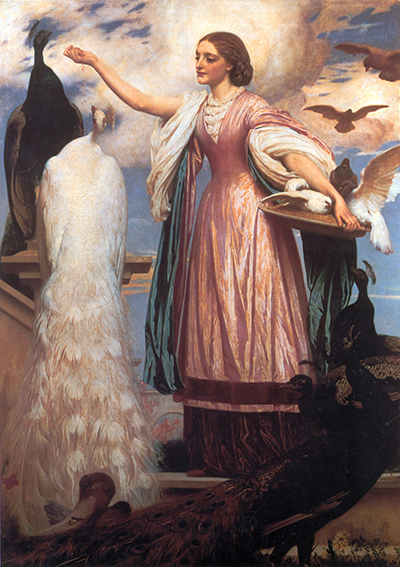A Girl Feeding Peacocks is one of Fredric Leighton's most famous art piece and has been reproduced by many other artists.
Frederic Leighton was one of the most acclaimed British creatives of the nineteenth century. The beneficiary of numerous national and global honours and distinctions, he was very much familiar with the royal family and with the majority of the extraordinary artists, journalists and legislators of the Victorian period.
He was conceived in Scarborough, to a family in the medical field. His dad was a medical specialist, and his granddad had been the personal doctor to the Russian regal family, where he earned an enormous fortune. This family riches constantly padded Leighton's work; his dad paid him a stipend for an incredible duration. Leighton's folks were stressed over his decision in a profession as he stated in a letter in 1879. "My folks encompassed me with each artistry facilities to get the hang of drawing, however, emphatically disapproved the possibility of my becoming a craftsman except if I could be famous in workmanship".
Luckily Leighton succeeded in getting to be 'famous in craftsmanship' with Queen Victoria purchasing his painting in the years 1855 and 1878. He arrived at the apex of his calling, turning into the President of the very well known art school known as the Royal Academy. He never wedded and before his demise from a cardiovascular breakdown in 1896. Later on, he was honoured, getting to be Lord Leighton, the respected Baron of Stretton. It is important to note that he was the only British craftsman to have been granted this respect and was later buried in the St Paul's Cathedral. Leighton liked to paint topics that were associated with old Greek and Roman folklore. He planned for his depictions to be outwardly excellent, and his work at that point and now has a notoriety for brilliant hues and decidedly drawn figures. Leighton's peers incorporated the famous French Impressionist artists and Renoir, Monet and many others.
Lord Leighton said that "Impressionism is a response from the old traditionalism. Yet an impressionist must never overlook that it is the deep sinking and not the outlaw impressions". His job at the Royal Academy incorporated the training of more youthful specialists. His incredible capacity for this is summarised in the expressions of one of his understudies; the stone carver Hamo Thornycroft who wrote the following, "he was very vigorous and went to considerable lengths to support the understudies. He was, also, a very inspiring expert". This specific art piece was created in Academicism. This is a unique style of painting and modelling created by European foundations of artistry.
Since the beginning, travelling was a big piece of Leighton's life. His family, the especially mother, disliked the atmosphere and dirtied condition of Britain, and she demanded the Leighton family to stay in Europe. Leighton this way generally travelled around Europe and could communicate in Spanish, French, German, and Italian. At 27 years he made his first outing to Africa, by visiting Algeria. It was an incredible start to his contribution to that part of the world and also the Middle East.




